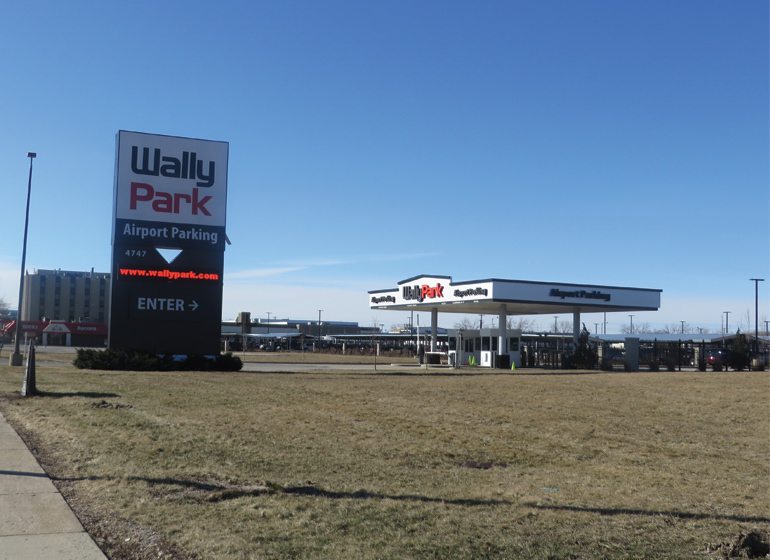In 2013, the Wyndham Milwaukee Airport Hotel & Convention Center was demolished to make way for the first phase of WallyPark, an off-site airport parking service.
Over the next three months, the 508-room hotel that stood for 55 years across the street from General Mitchell International Airport on South Howell Avenue was turned into surface parking by WallyPark’s Los Angeles-based parent company, which bought the site in a sheriff’s auction after the hotel went into foreclosure.
The same year the WallyPark facility was created, Aerotropolis Milwaukee established a multi-jurisdictional partnership among the five communities that physically border the airport to further strengthen their mission to improve the area around the airport.

The WallyPark development, at the key corner of Howell and Layton avenues, was an obvious loss in that effort, said Scott Yauck, Aerotropolis Milwaukee board president.
“That corner was a mistake, but the zoning allowed for parking. That property was acquired, and there was nothing that could have been done to stop it,” Yauck said. “If any area (near the airport) could support national retail, that corner was it. This would have been a good sell for a good catalytic project and this is a good example of why, going forward, we need a plan.”
Aerotropolis Milwaukee was originally formed seven years ago as a 21-member public-private partnership to improve and attract development to the airport area. Its progress has been slow going.
The 2013 multi-jurisdictional partnership led the airport-bordering communities to adopt an “Interlocal Cooperation Agreement,” which was intended to foster growth. In February, Aerotropolis Milwaukee announced it had partnered with the Southeastern Wisconsin Regional Planning Commission to lead an effort to create a development plan.
This plan is intended to continue identifying where future growth and economic development should be occurring around the airport and suggest changes to each community’s comprehensive plan.

This is where the challenge lies: the area surrounding the airport physically touches the cities of Milwaukee, Oak Creek, South Milwaukee, Cudahy and St. Francis, each of which has different land use plans and priorities.
The airport is at the border of each of these communities, which is not where the focus of economic development has been, Yauck said.
“This is a huge challenge and it is very political, but if we could create an identity around the airport and its own planning district, we could think different about the whole area,” Yauck said.
Yauck, president and chief executive officer of Cobalt Partners LLC, a Milwaukee-based real estate development firm, has both a professional and a personal interest in seeing Aerotropolis succeed.
“I was born and raised five blocks from the airport, so I have a fondness for this area from that standpoint,” Yauck said. “But I am also concerned for the vibrancy of the city. I love the Milwaukee metro area. It’s exciting to see the changes, but it is going to come to a point where we say, ‘Now what?’ unless we are connected globally.”
Aerotropolis concepts have been implemented in 38 cities across the country. A core principle of Aerotropolis implementation is that development can occur more efficiently if land use plans accommodate transportation and logistics uses around an airports.
In some cities, the concept has been a catalyst for incredible economic development. For example, the Dallas/Fort Worth International Airport, which is 17 miles from Dallas and Fort Worth, has turned into its own city, with three hotels, office space, a golf course and an Infiniti car dealership.
According to a 2013 University of North Texas study, the Dallas/Fort Worth International Airport is responsible for $31.6 billion in annual economic activity in the region.
Aerotropolis efforts in Atlanta also are paying off. In 2015, Porsche opened a $100 million, 27-acre headquarters complex that includes a 13,000-square-foot conference center and driver development track at the Hartsfield-Jackson Atlanta International Airport.
Yauck realizes the development done near airports in Dallas, Atlanta, Denver and other larger metropolitan cities will not likely be replicated in Milwaukee, which is smaller and has an airport that serves far fewer passengers. But he said the cooperative approach those cities have taken to advance the areas around their airports can be.
“In today’s world of email and social networking, people could fly into an airport, stay at a hotel there and fly out,” Yauck said. “We certainly can do better than we are. Can you imagine if the two blocks surrounding our area became an airport district? It could make a huge difference.”
Aerotropolis Milwaukee has been making the rounds at the surrounding communities’ board meetings looking for additional buy in. The group is hoping to hold an event in June to connect elected officials with the real estate community to generate additional excitement for the development plan.
The plan identifies six growth areas: Layton Town Center Area, Layton/Lake Parkway Area, Milwaukee South Industrial Area, 13th/27th Street Area, Oakwood Road Area and Loomis Road Area.
The plan also recommends transportation improvements designed to maximize connectivity between Aerotropolis-supporting land uses, including: high-quality streets and highways; a greatly improved and expanded transit system; infrastructure improvements to quickly move freight to and from the Aerotropolis; and a well-connected bicycle and pedestrian network. Transportation funding mechanisms have not been identified.
Milwaukee Alderman Terry Witkowski, who represents the area bordering the airport and was instrumental in starting Aerotropolis Milwaukee, believes the airport area is improving.
“We just had a car repair shop come to (the Board of Zoning Appeals) that wanted to go where a restaurant used to be and we denied them because it is not what Aerotropolis is trying to do,” Witkowski said. “I think we’ll have several small wins. And because we are all separate communities, we won’t know we have a win because it will be an Aerotropolis win, but it will be for the good of everyone.”

